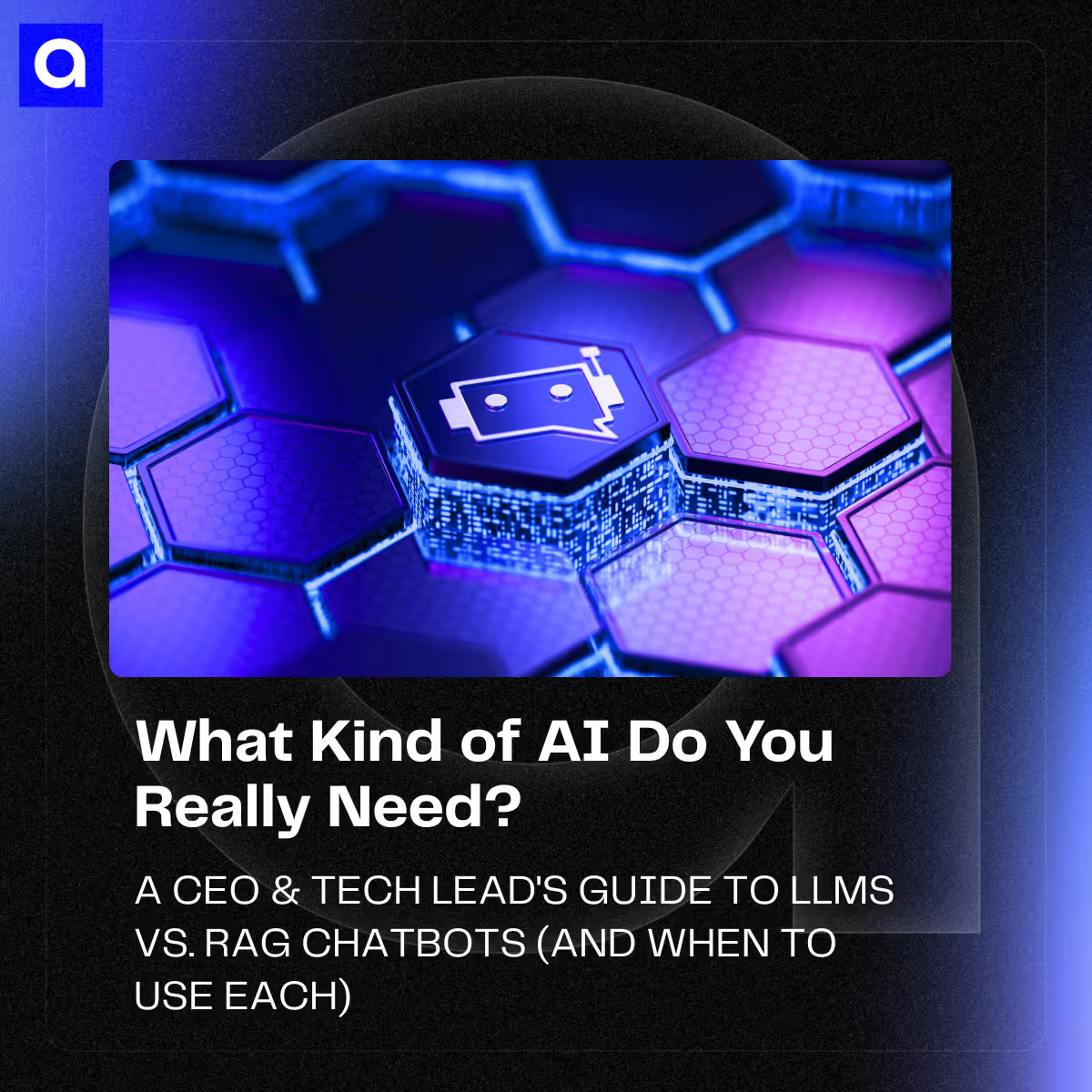.avif)
The Opening Dilemma
You're the CEO or technical lead in an HR organization. The buzz around "AI chatbots," "large language models (LLMs)," or "retrieval-augmented generation (RAG)" is deafening. Everyone insists you should integrate AI "yesterday." But here's the real question: what kind of AI actually makes sense for your business, your budget, and your customer (or employee) experience?
The worry is real—making the wrong technical choice could mean overspending or ending up with subpar results that erode trust. You don't want to throw money at a trend, but you also need to deliver something that truly stands out.
What follows is a grounded, no-nonsense guide that cuts through the hype: how to pick between LLM and RAG for your HR use cases, what the real cost trade-offs look like, and who should actually build it (in-house team, partner, or SaaS solution).
What, Why, and How (and What's Next)
1. What are LLMs vs RAG chatbots (and hybrids)?
LLM-only chatbot (fine-tuned or prompt-based): The model is trained or prompted to answer directly from its learned parameters. There's no external retrieval happening—it "remembers" or infers based on what it already knows.
RAG (Retrieval-Augmented Generation): The system retrieves relevant documents or knowledge (think employee handbooks, policy docs, contracts, training content) and then has the LLM generate answers grounded in that retrieved content. AWS describes RAG as optimizing LLM output by referencing an authoritative knowledge base outside of training data.
Hybrid / dynamic routing (self-route): Some queries go through RAG, others through a longer-context LLM path, depending on cost and performance trade-offs. Recent research on self-routing methods and self-reflective RAG shows how systems can intelligently decide which path to take based on query complexity.
In short: the difference is whether the LLM operates in isolation versus tapping into an external knowledge store.
2. Why choose one over the other (and what the trade-offs are)
Key takeaways:
- If your HR use case demands the latest policies, legal compliance, document lookups, or highly factual answers, RAG (or hybrid) is almost always safer.
- If your use case is more generative—like coaching, writing assistance, or stylistic output where you want the model to "own" the voice—then LLM-based fine-tuning may shine.
3. How much does this cost (and how to budget)?
Many organizations underestimate what it takes to run a robust RAG/LLM system. Below is a realistic cost breakdown for enterprise scale, backed by actual benchmarks.
Typical cost categories for RAG systems
Infrastructure (compute, storage, network): Depending on cloud choice and scale, this can run thousands of dollars per month. AWS documentation shows that vector search clusters and indexing can cost tens of thousands annually. The recent introduction of Amazon S3 Vectors promises up to 90% cost reduction compared to traditional vector database approaches.
Inference / LLM cost: Each query (prompt plus response tokens) costs money. At high throughput, these add up quickly.
Vector DB / search & index management: Systems like Pinecone, Weaviate, or managed services add recurring costs.
Developer, data, and integration costs: Analysis from industry practitioners shows hidden operational costs can include infrastructure ($3–5K), LLM ($1–3K), vector DB ($3.5–6K), and dev ops ($10–20K per month) in some enterprise settings.
Fine-tuning / model updates / versioning (if applicable): Especially if you maintain your own LLM, research on fine-tuning costs shows these expenses can be significant.
Monitoring, logging, guardrails, fallback logic: You'll need human supervision, error detection, and explainability—especially critical in HR contexts.
Bottom line estimates: A full RAG-based chatbot for enterprise scale can cost $17,000–34,000/month in production in a sophisticated setup. Building internal systems (engineering time, ML ops overhead) may push you past $750,000 to $1 million in total cost before it stabilizes.
Also, purely LLM-based solutions carry steep costs in training, inference, and the risk of hallucination or domain drift if you can't fine-tune often.
Cost optimization strategies
- Use dynamic routing / self-route: Send only complex queries through expensive LLM paths; simpler ones to cheaper retrieval paths. Research shows this can significantly reduce costs.
- Pre-filter / cache frequent queries, batch embedding computations
- Choose models appropriately: Smaller, faster models for many queries; bigger ones for fallback
- Monitor cost per query and set thresholds
- Use managed services where possible (vector DB, indexing) to reduce infrastructure overhead
4. What technology / approach to pick—and who should build it
Here's a decision framework tailored specifically to HR organizations:
Step 1: Define your use case and risk tolerance
Low-risk, high-volume FAQ / HR chatbot (e.g., leave policies, benefits, handbook Q&A): Start with a RAG-based chatbot.
Generative tasks (coaching, writing, training content): Use LLM fine-tuning or prompt orchestration, possibly combined with retrieval.
Complex "agentic" AI (e.g., multi-step workflows, approvals): Likely a hybrid or modular architecture (RAG + planning + external APIs).
Step 2: Evaluate your internal capabilities vs partner / SaaS
Step 3: Choose architecture & technology stacks
- Use proven LLM APIs (OpenAI, Anthropic, etc.) for initial models to reduce dev burden
- Combine with vector search systems (Pinecone, Weaviate, Milvus) for RAG—or leverage Amazon S3 Vectors for cost-effective storage
- Use orchestration frameworks like LangChain or LlamaIndex for chaining retrieval and generation
- Build fallback logic and guardrails: If confidence is low, route to human oversight
- Log and monitor extensively: Track which queries fail, latency issues, and hallucinations
- Plan for incremental rollout: Start small, grow your knowledge domain gradually
Conclusion
You don't need to bet blindly on the "biggest" model or the latest AI trend. The real decision comes down to matching architecture to your specific use case, risk tolerance, and budget constraints.
RAG-based chatbots enable grounded, up-to-date responses with more predictable costs—ideal for HR scenarios where accuracy and compliance matter. Pure LLMs or hybrids excel when tone, generative style, or deep reasoning dominate the task. But here's the catch: the hidden costs of engineering, maintenance, and oversight can absolutely blow up budgets if left unaccounted for.
Picture this—an HR assistant chatbot that reliably answers employee questions with current policies, drafts training outlines on demand, and frees up your HR team to focus on strategic work. You launch it incrementally, control scaling carefully, and avoid nasty surprises. Your leadership sees tangible value. Your team trusts the system because it actually works.
Start with a small proof of concept in a focused domain—maybe FAQ responses plus policy lookups. Work with a trusted vendor or your internal ML lead to build a simple RAG path. Monitor cost per query and accuracy religiously. Iterate based on real feedback. Over 6–12 months, scale to more domains thoughtfully.
If you'd like help choosing a partner or designing your architecture roadmap, I'm here to assist. We can create a decision matrix or tech stack comparison tailored specifically to your HR use cases—whether that's benefits administration, compliance tracking, or performance management.
Let's build something that actually delivers value—not just checks an AI box.


.avif)
